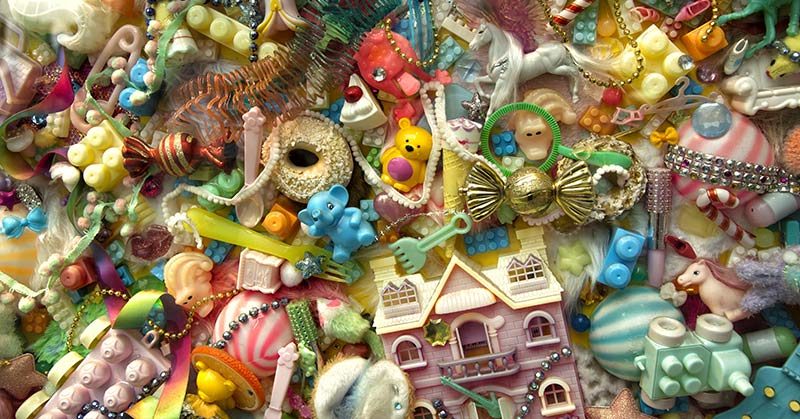Dolls, trucks, Lego, and action figures are all classic children’s toys that have one thing in common: they’re all made of plastic. In fact, in 2017 the website ecobirdy.com conducted a survey which found that 90 percent of all children’s toys are made entirely out of plastic [1].
These brightly-colored plastic toys are placed conveniently at children’s eye-level at the store checkout, so they see the fun toy right when they’re tired and over-stimulated from shopping for the last hour. You, the parent, are also tired from dragging your kid around while you do errands, and so in order to avoid the imminent tantrum you give in to their begging and buy their object of desire.
The question is, though, do our kids really need these toys, and how are they impacting the health of your child and the planet?
Read: New plant-based bottles will degrade in a year
Plastic Toys and the Environment
According to environmentalists, children’s toys are contributing to the amount of plastic found in landfills and oceans [2].
The toy industry is massive, and in 2019 the total toy sales across the globe reached over 90 billion dollars [3]. Plastic toys, which tend to be fun-looking and brightly colored, make up approximately 90 percent of that market [4].
These toys are made cheaply and are not meant to last, since kids move on quickly to the next craze anyways. A poll by the British Heart Foundation conducted a survey which found that more than 25 percent of parents have thrown away toys that are in perfect working order, and that children have, on average, four toys that they’ve never played with even once [2].
Like any other type of plastic, plastic toys have a negative impact on the environment, since the plastic they are made from is nearly impossible to recycle.
“If it’s a flimsy plastic toy that clearly isn’t going to have more than a lifetime of a few days or weeks, would you really want to be getting that material?” said Kevin Brigden, senior scientist at Greenpeace International Science Unit. “As soon as you open it, you’ll be putting it into the waste stream.” [5]
Plastic generates many problems for the environment since it takes thousands of years to break down, and even when it does, it leeches microplastics into our oceans and soil that are ending up in human bodies [6].
One way we have tried to address the plastic problem is through recycling. Unfortunately, this solution has been largely ineffective because less than ten percent of plastic waste gets recycled [7].
What makes the plastic toys more problematic than other types of plastics is that they have no hope of being recycled- they are essentially destined for the landfill at some point in time. Brent Bell, vice president of recycling at Waste Management, a company that provides recycling solutions to businesses and residences in North America, says that very few toys are good candidates for recycling [5].
This is because typically plastic toys are also composed of other materials, like metals, that can’t be separated out and thus are prohibitive for recycling centers [5].
Plastic Toys and Your Child’s Health
Plastic toys don’t just impact the health of the environment- they could be impacting your child’s health, too. One example of this is phthalates, which is a chemical that is used to soften the plastic that toys are made from. This chemical has been linked to a number of health issues including birth defects, cancer, and diabetes [8].
Since children, particularly babies and young toddlers, are constantly putting their toys in their mouths, they are at an increased risk for experiencing health complications due to phthalate exposure.
There is also a mental component that happens when you give in to your child who is having a meltdown over wanting the shiny plastic toy on the shelf: a rush of dopamine floods their brain.
Dopamine is a chemical that controls many functions including behavior, emotion, and cognition, and also communicates with the front part of the brain that’s associated with pleasure and reward [9].
You know that rush of happiness you get when you buy something new? That’s a dopamine response, but we tend to refer to it more commonly as “retail therapy”. When we constantly give in to our children’s tantrums over new toys, we are teaching them that having a meltdown is an effective way to get a “reward”, and setting them up to turn to shopping and over-consumption as a means to happiness.
It’s Time to Make a Change
Environmental experts are now encouraging parents to look to the toys of the past, that were made with more sustainable materials and lasted longer. Items made from wood, cotton, natural rubber, and metal are all better for the environment and can be good replacements for plastic toys.
The other problem with plastic toys is the rate at which children go through them. Children now receive plastic toys for birthdays, Christmas, in grab-bags at parties and many other places, but these products only provide entertainment to a child for a very short period of time before they get forgotten and eventually discarded.
Perhaps it is time we reevaluate how many toys our kids actually need, and begin encouraging them to play with the toys they already have, instead of constantly needing more. In a world that is so heavily focussed on consumerism, this can be a difficult task, but it is more than worth the effort.
Keep Reading: The Most Jolly and Wasteful Time of Year. 15 Tips for a “Green” Holiday Season
- https://www.ecobirdy.com/blogs/news/plastic-toys
- https://www.bbc.com/news/science-environment-47868871
- https://www.toyassociation.org/ta/research/data/global/toys/research-and-data/data/global-sales-data.aspx?hkey=64bda73b-80ee-4f26-bd61-1aca29ff2abf
- https://plastics-themag.com/Plastic-shakes-up-the-toy-industry
- https://www.huffingtonpost.ca/entry/your-kids-toys-are-killing-the-planet_n_58ffa383e4b0f5463a1a9472?ri18n=true
- https://www.nationalgeographic.com/environment/2018/10/news-plastics-microplastics-human-feces/
- https://www.nationalgeographic.com/news/2017/07/plastic-produced-recycling-waste-ocean-trash-debris-environment/
- https://www.ecocenter.org/healthy-stuff/reports/vinyl-floor-tiles/flooring_phthalate_hazards
- https://share.upmc.com/2016/09/about-brain-chemicals/

